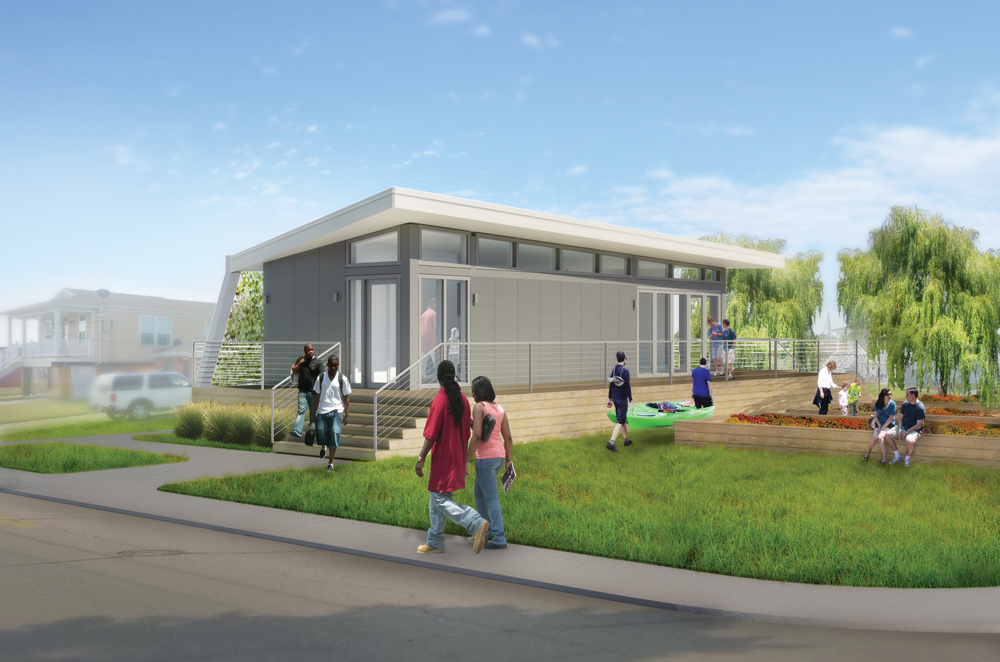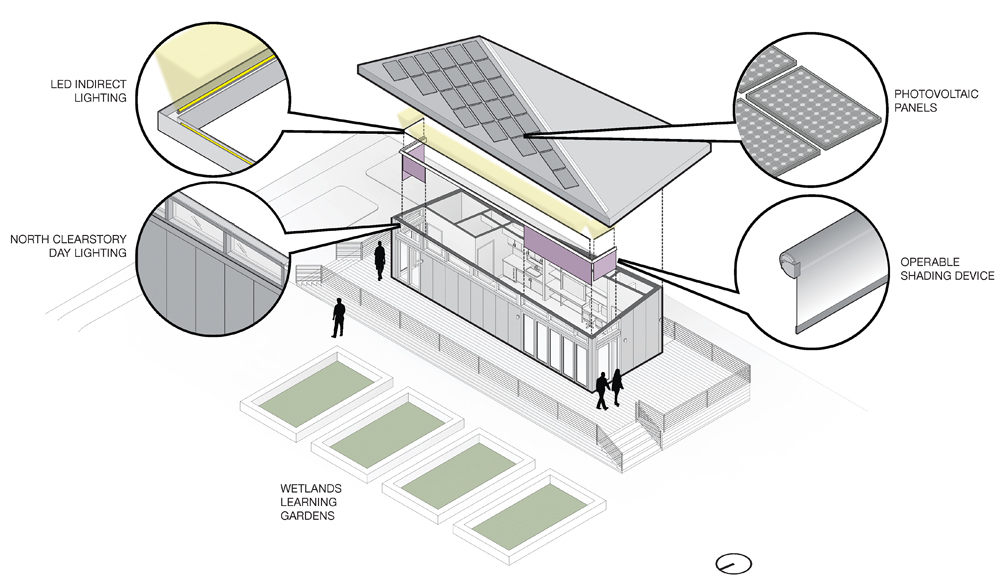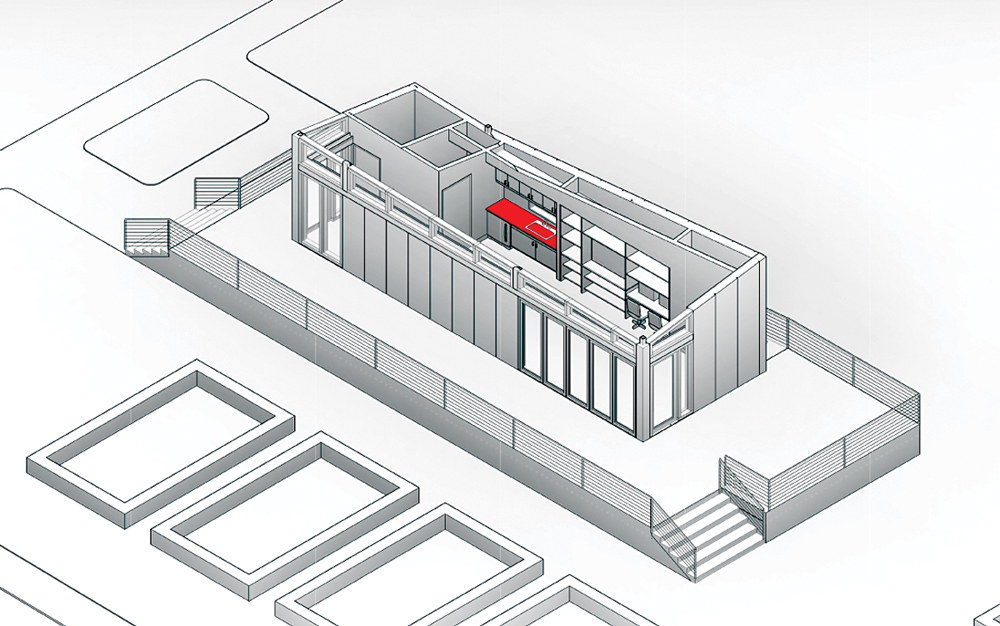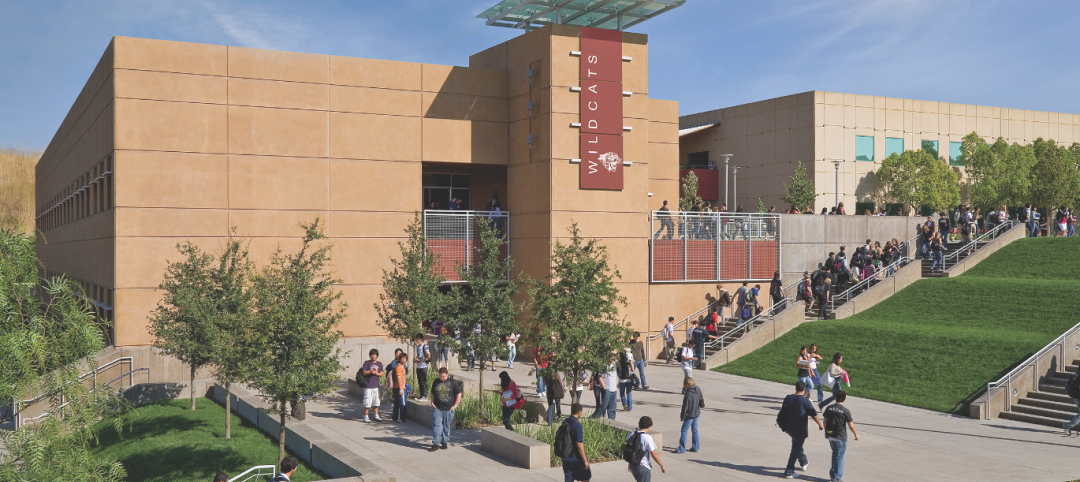Building Design+Construction has partnered with building product manufacturers and the Lower 9th Ward Center for Sustainable Engagement and Development (CSED) to create a modular classroom/lab/community center, on display at the GreenZone exhibit during Greenbuild 2014 in New Orleans, October 21-23.
At the conclusion of Greenbuild, the Environment Education Classroom will revert to the possession of the CSED and move to its permanent Lower 9th Ward home in a residential block south of the Bayou Bienvenue Wetlands Triangle viewing platform. It will serve as a community center and K-12 classroom for educating students on water quality, water conservation, storm water management, and resiliency.
Designed by New Orleans firm Eskew+Dumez+Ripple (EDR), recipient of the 2014 AIA Architecture Firm Award, and TLC Engineering for Architecture, and built by local design-builder Broadmoor LLC, the structure targets net-zero energy use. Sustainable design elements include a pitched butterfly roof to collect and transport rainwater to polypropylene tanks underneath the building.
How you can contribute
After being on display at the Morial Convention Center at Greenbuild October 21-23, the Environment Education Classroom will revert to the possession of the CSED. The 560-sf modular structure will be moved to its permanent home in a residential block just south of the Bayou Bienvenue Wetlands Triangle viewing platform.
Moving the structure from the convention center and setting it up at the CSED site will require about $30,000 in site work to lay the foundation, connect the utilities, and construct ADA-compliant decks and entryways, according to USGBC Louisiana Executive Director Shannon Stage.
USGBC Louisiana, a 501(c)(3) charitable entity, is seeking tax-deductible donations from Greenbuild attendees, AEC firms, and others interested in the CSED Environment Education Classroom to help offset those costs. Credit-card donations may be made via the USGBC Louisiana website, usgbclouisiana.org.
Any excess funds that are collected will be used for educational materials and ongoing operations of the facility, says Stage.
The water will be reused to irrigate wetland beds. The building is 100% daylit per LEED v4 requirements, enhanced by a triangular piece of glass around the entire façade that allows further daylight penetration into the structure.
The GreenZone sponsors include: Access Lighting, Accoya, ASSA ABLOY, Bayer MaterialScience, Carlisle Syntec Systems, CENTRIA, LG, Mecho Systems, and Modular Building Institute.
About the Structure
The Environment Education Classroom will serve a variety of functions in the Lower 9th Ward community. It will be an education center, meeting space, and laboratory all in one and within a footprint of 15 feet by 40 feet.
The main space is designed to be as open and flexible as possible, complete with movable furniture to be reconfigured as needed. Since the number of people sharing the building at any one time can change, EDR went with a demand-controlled ventilation mechanical system, which will respond to the number of occupants in the room at any given time. The architects wanted the building to be 100% daylit, per LEED v4, and so engaged extensive daylight simulations for testing.
Taking that indoor-outdoor connection a step further, a portion of the north facade will feature a folding wall system that can be opened and closed as desired.
From the exterior, the pitched butterfly roof is one of the visual highlights. But it's not just beauty for beauty's sake—the roof will be able to collect rainwater and carry it down to the polypropylene tanks underneath the building; The rainwater will be reused to irrigate the wetland beds CSED plans to install around the building.
For more information on the Environment Education Classroom, visit www.BDCnetwork.com/greenzone2014.
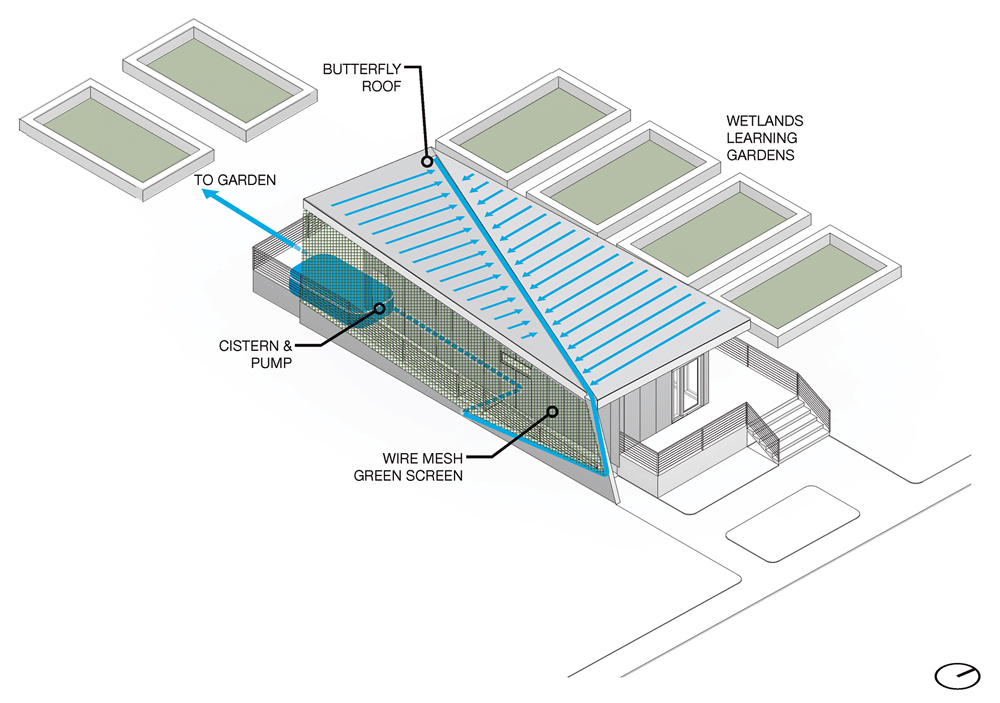
Schematic by New Orleans design firm Eskew+Dumez+Ripple reveals some of the sustainbility features of the modular classroom/lab/community center. The facilty’s focus on water/stormwater education is made apparent to visitors and the community via the rainwater retention system on the roof, the cistern and pump, the vegetated rainscreen, and wetlands learning gardens. Design/build firm Broadmoor LLC is in charge of construction. All illustrations: Eskew+Dumez+Ripple
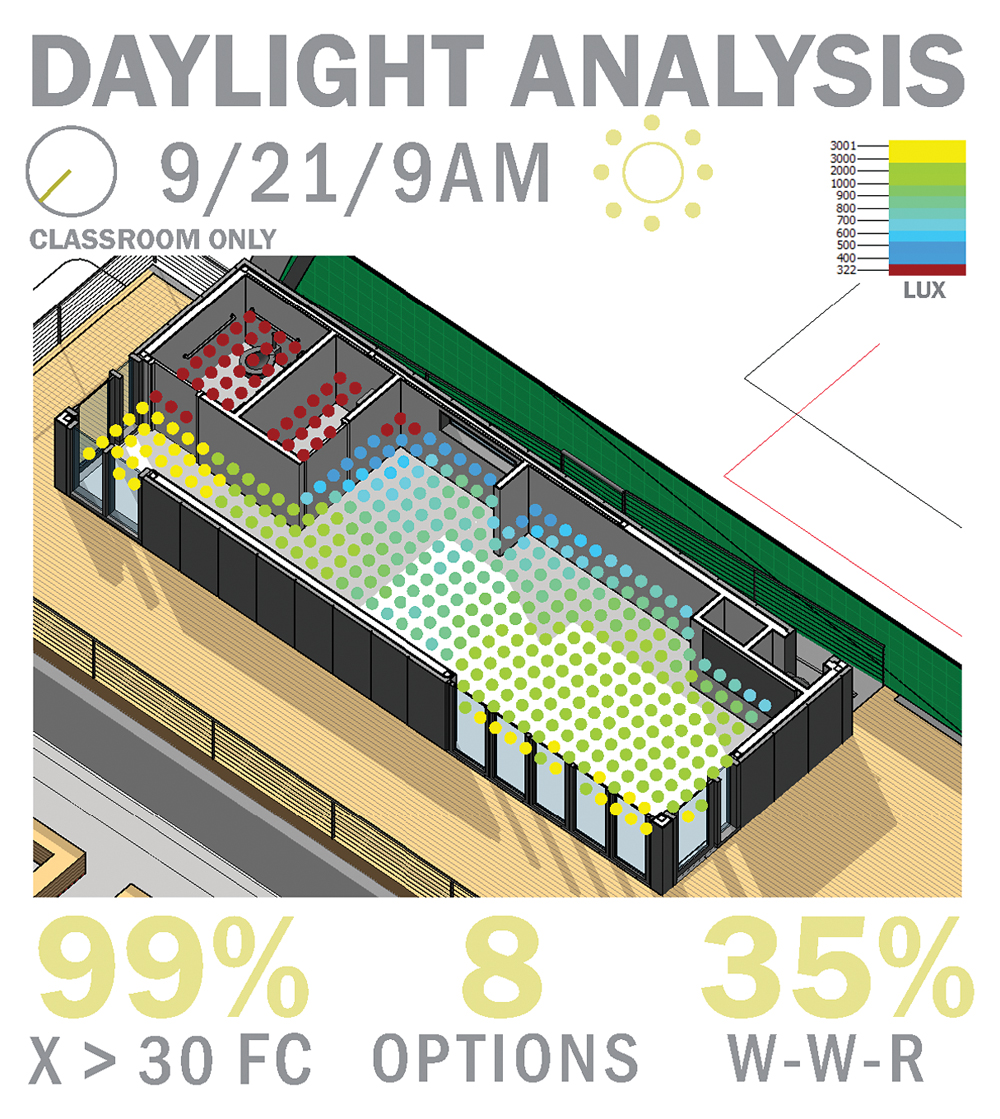
Eskew+Dumez+Ripple conducted extensive daylight and energy analyses to make the modular facility as energy efficient as possible under LEED v4.
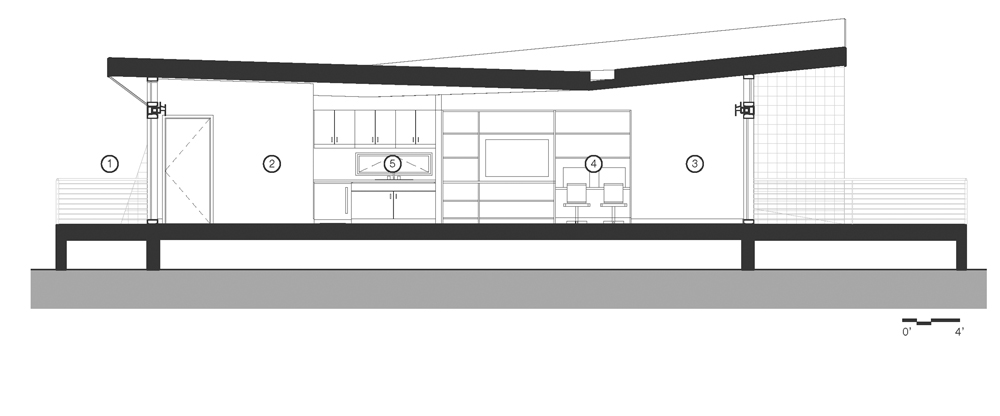
1. Entry 2. Exhibit display 3. Classroom 4. Computer Station 5. Kitchen. Section of Environment Education Classroom reveals multiple use options in a compact space. Designer Eskew+Dumez+Ripple was named AIA Architecture Firm for 2014.
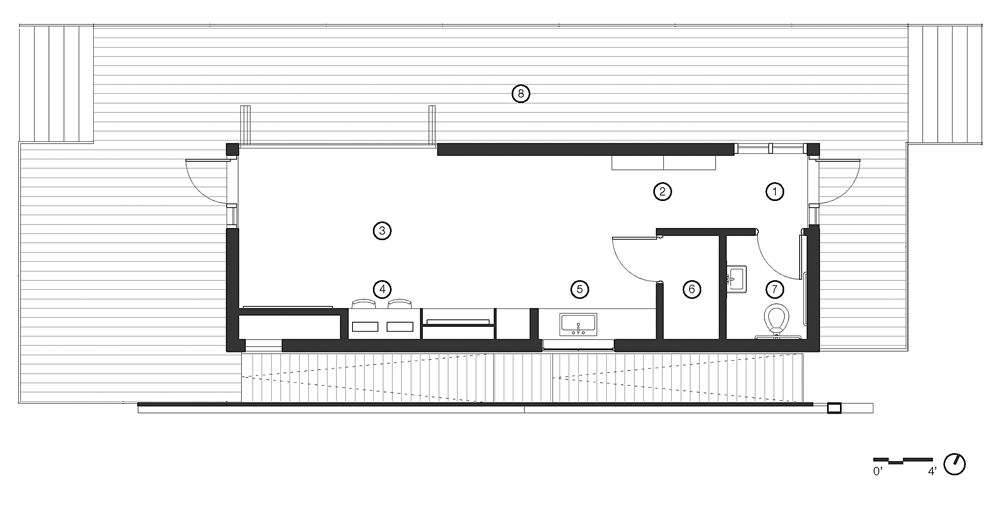
1. Entry 2. Exhibit display 3. Classroom 4. Computer Station 5. Kitchen 6. Closet 7. Toilet Room 8. Deck. Floor plan of the 560-sf Environment Education Center. Designers from Eskew+Dumez+Ripple worked pro bono with design/build experts from Broadmoor LLC to gain efficient use of the tight space. The facility will be used as a water/stormwater classroom for K-12 students, as a community center, and as a water-research lab.
Schematic by Eskew+Dumez+Ripple shows some of the sustainable strategies being employed in the module. Design-build firm Broadmoor LLC has used the project as an education opportunity for a dozen of its workers.
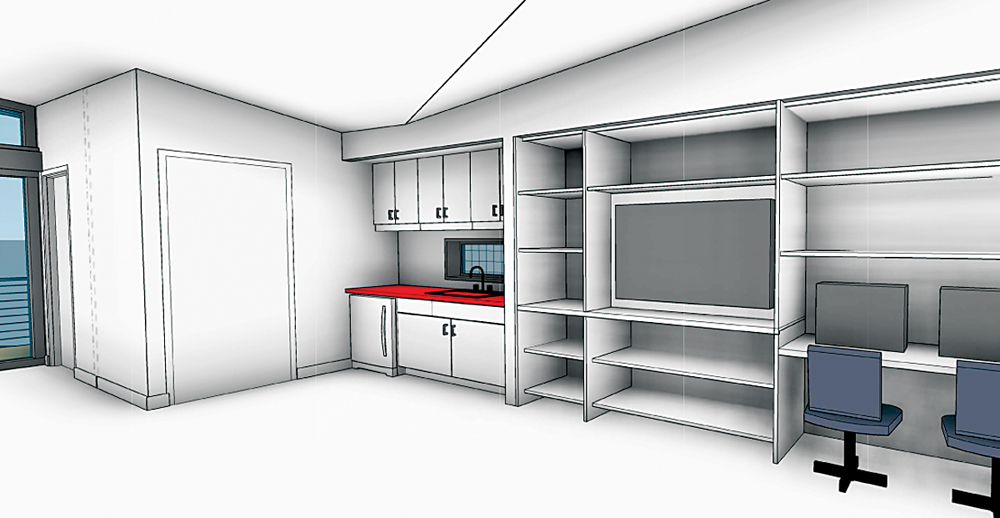
Renderings by Eskew+Dumez+Ripple provide advanced views of the Environment Education Classroom, at this writing under construction at Broadmoor LLC. Materials and systems for the project were donated by Access Lighting, Accoya, ASSA ABLOY, Bayer MaterialScience, Carlisle SynTec, CENTRIA, LG, and MechoSystems; the Modular Building Institute provided technical guidance. The facility will be sited about 100 yards from Bayou Bienvenue in the 9th Ward.
Related Stories
| Jan 20, 2011
Community college to prepare next-gen Homeland Security personnel
The College of DuPage, Glen Ellyn, Ill., began work on the Homeland Security Education Center, which will prepare future emergency personnel to tackle terrorist attacks and disasters. The $25 million, 61,100-sf building’s centerpiece will be an immersive interior street lab for urban response simulations.
| Jan 19, 2011
Biomedical research center in Texas to foster scientific collaboration
The new Health and Biomedical Sciences Center at the University of Houston will facilitate interaction between scientists in a 167,000-sf, six-story research facility. The center will bring together researchers from many of the school’s departments to collaborate on interdisciplinary projects. The facility also will feature an ambulatory surgery center for the College of Optometry, the first of its kind for an optometry school. Boston-based firms Shepley Bulfinch and Bailey Architects designed the project.
| Dec 28, 2010
Project of the Week: Community college for next-gen Homeland Security personnel
The College of DuPage, Glen Ellyn, Ill., began work on the Homeland Security Education Center, which will prepare future emergency personnel to tackle terrorist attacks and disasters. The $25 million, 61,100-sf building’s centerpiece will be an immersive interior street lab for urban response simulations.
| Dec 17, 2010
Sam Houston State arts programs expand into new performance center
Theater, music, and dance programs at Sam Houston State University have a new venue in the 101,945-sf, $38.5 million James and Nancy Gaertner Performing Arts Center. WHR Architects, Houston, designed the new center to connect two existing buildings at the Huntsville, Texas, campus.
| Dec 17, 2010
Alaskan village school gets a new home
Ayagina’ar Elitnaurvik, a new K-12 school serving the Lower Kuskikwim School District, is now open in Kongiganak, a remote Alaskan village of less than 400 residents. The 34,000-sf, 12-classroom facility replaces one that was threatened by river erosion.
| Dec 17, 2010
New engineering building goes for net-zero energy
A new $90 million, 250,000-sf classroom and laboratory facility with a 450-seat auditorium for the College of Electrical and Computer Engineering at the University of Illinois at Urbana/Champaign is aiming for LEED Platinum.
| Dec 17, 2010
How to Win More University Projects
University architects representing four prominent institutions of higher learning tell how your firm can get the inside track on major projects.
| Dec 6, 2010
Honeywell survey
Rising energy costs and a tough economic climate have forced the nation’s school districts to defer facility maintenance and delay construction projects, but they have also encouraged districts to pursue green initiatives, according to Honeywell’s second annual “School Energy and Environment Survey.”
| Nov 29, 2010
New Design Concepts for Elementary and Secondary Schools
Hard hit by the economy, new construction in the K-12 sector has slowed considerably over the past year. Yet innovation has continued, along with renovations and expansions. Today, Building Teams are showing a keener focus on sustainable design, as well as ways to improve indoor environmental quality (IEQ), daylighting, and low-maintenance finishes such as flooring.
| Nov 23, 2010
Honeywell's School Energy and Environment Survey: 68% of districts delayed or eliminated improvements because of economy
Results of Honeywell's second annual “School Energy and Environment Survey” reveal that almost 90% of school leaders see a direct link between the quality and performance of school facilities, and student achievement. However, districts face several obstacles when it comes to keeping their buildings up to date and well maintained. For example, 68% of school districts have either delayed or eliminated building improvements in response to the economic downturn.


